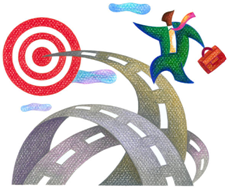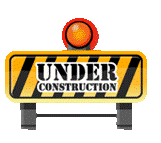Seven Imperatives To Inventing Your Company’s Future
By Paul David Walker – Excerpt from the book, Cracking the Business Code
[dropcaps type=”circle” color=”” background=””]W[/dropcaps]hile helping CEOs and executive teams at mid-sized and Fortune 500 companies throughout the years to align strategy, structure, and organizational culture, I have observed both great and unfit leaders and realized that leaders can literally invent the future of their companies and their lives.  Today’s CEOs need teams with clear missions, a sense of urgency, the stillness of a master and explosive targeted actions. Like shooting rapids, there is a correct course in the currents of change; there are also those that will run you into rocks and those that will drown you and your company in the Business Industry.
Today’s CEOs need teams with clear missions, a sense of urgency, the stillness of a master and explosive targeted actions. Like shooting rapids, there is a correct course in the currents of change; there are also those that will run you into rocks and those that will drown you and your company in the Business Industry.
Companies that succeed in today’s volatile business economy must conquer obstacles the way a championship basketball team does in a “FastBreak,” overcoming the insecurities that hold them back and responding instantly to the flow of the game of business.
Before leaders can accomplish anything, they must first understand themselves and the present reality, challenge their own thinking, communicate a well thought-out and concise strategic direction, and define a clear and actionable plan for execution. No matter how much research is done, a leader must make the final call. To make that call with confidence, a leader must know the answer or how to find the answer, and he or she must communicate clearly, simply, and concretely in a compelling manner. Only then will a team have the faith to follow and achieve the company’s objectives.
The following seven imperatives act as a roadmap for surpassing common business hurdles to achieve success and invent a well-designed future for your business or your life. These steps work for everything from building a porch on the front of your house to improving your life, creating a great company, or galvanizing a nation.
1. Knowing the Answer: The first step, of course, is to know the right answer. But more important, you have to know when you know the right answer in business or in life. It is not enough to say, after it is too late, “I knew that.” In any endeavor, there is a correct course to set. That course is based on the realities of the market, competitive analysis, and the true differentiation of the product, service, or team being evaluated. A leader must be fully present in the reality of the moment in order to succeed, rather than being attached to their thoughts and beliefs about that reality. The leader must know the difference between his ego’s hopes and fears and true reality. This involves a deep understanding of yourself and the flow of cause and effect. A leader must learn the art of “integrative presence,” which is like being “in the zone.” The future emerges from the present; the past is distorted by our beliefs, emotions, and the limits of our perceptual abilities. “Integrative presence” allows you to integrate the reality of the moment with your intention for the future; thus responding correctly to the flow of the game. Product cycles are shortening, business is becoming far more complex, and global competition requires speed and accuracy. Without the correct understanding of the present reality and how that it is emerging into the future, you cannot move with accuracy and speed. A leader must dance with the present while simultaneously carrying an intention for the future. As you do this, you know how to move.
2. Communicating a Clear, Compelling Picture of The Future State: You cannot create something you cannot conceive. Once a leader knows the answer or the right course, that leader must be able to conceive and communicate the opportunity and understand how the team can capture that opportunity. Until this team can see, feel, and hear the calling of  the opportunity that present reality represents, they cannot truly follow. Without this clear picture, each team member will create his or her own picture of the future, causing friction and slowing the overall progress of the team. The leader’s presence and authentic commitment to the mission draws followers within the company and in the marketplace. The more clearly the picture of the future state is, the easier it is to create. Without a clear picture of the future in the mind of each leader, chaos will ensue.
the opportunity that present reality represents, they cannot truly follow. Without this clear picture, each team member will create his or her own picture of the future, causing friction and slowing the overall progress of the team. The leader’s presence and authentic commitment to the mission draws followers within the company and in the marketplace. The more clearly the picture of the future state is, the easier it is to create. Without a clear picture of the future in the mind of each leader, chaos will ensue.
3. Creating Total Commitment: After the team can see and feel the possibility of the future, their commitment grows.
“Until one is committed, there is hesitancy, the chance to draw back, always ineffectiveness concerning all acts of initiative and creation.” — Goethe
First, the leader must be fully committed to the mission and then inspire the same level of commitment in those who follow. Part of being a leader is to challenge teams to face their fears and change their habits. What prevents them from committing is one of the greatest fears of mankind: the fear of the unknown. No one likes to walk into a dark room. As leader, you have to light the future with your vision. To move forward, you must paint a picture of a new reality to give your team confidence and keep them totally engaged. The clearer and more compelling this picture of the future state becomes, the more committed the team becomes. The same is true for the marketplace and your customers.
4. Acknowledging and Responding to Present Reality: Leaders who fall short of their goals have often skipped or distorted this step. No matter how committed a team is to a mission, having the wrong starting point can make plans useless. Knowing the good, the bad, and the ugly about any situation they’re facing allows the team to build plans that are targeted and effective. The challenge here is that people hate to be wrong, and they find ways to make reality comport with their beliefs. This is the problem with the belief in “positive thinking.” It often skips this step and moves too quickly to planning and action. Pessimists, because of their negative beliefs about life, give up at this step, feeling overwhelmed and hopeless. A plan that is not grounded in reality, no matter how clear and committed the team, will lead you over a cliff. If someone were to give you directions to Chicago and thought you were in Los Angeles, when in fact you were in Miami, you would become lost no matter how good the directions. A leader and his team must honestly face their weaknesses and misconceptions to invent the future. It is best to always come back to this imperative.
5. Developing Targeted Action Plans: Having passed through the first four steps, it becomes easier to create targeted plans, which provide a roadmap that enables teams to deliver focused execution. The problem here is often that when things are not going well, leaders change the mission instead of adjusting the action plans. This means that they did  not do the work in the first four steps. If you know and are committed to the mission, you will know to change the plan, not the mission. With the right plan, a team will surpass competitors while learning about themselves. Even at the final step, there may be obstacles, doubts, and fears to overcome. Be on guard for hesitation. A leader must not falter due to the team’s fears.
not do the work in the first four steps. If you know and are committed to the mission, you will know to change the plan, not the mission. With the right plan, a team will surpass competitors while learning about themselves. Even at the final step, there may be obstacles, doubts, and fears to overcome. Be on guard for hesitation. A leader must not falter due to the team’s fears.
6. Having the Courage to Act Quickly: When you have all of the above steps in place, your fears are less likely to interfere—but they may still prevent you from implementing the plan. Courage to confront your fears and those of the team sets a true leader apart from someone who knows the answer but lacks the courage to act and lead. Once a leader knows the answer, that leader never gives up. With shortening product cycles and limited capital, leaders must first define the markets, enter them, and create excitement. With targeted actions that everyone believes in, the leader forms FastBreak Action Teams that are infused with clarity and confidence to reach the new reality. With good marketing and branding, the marketplace will have the same courage.
7. The Stillness of a Master: In martial arts matches, it is said that a master watching a match can tell who will win as the competitors bow to each other before the match. It is the one who has the most stillness, or the most presence. In moments of stillness, the motion around you slows and you can see, feel, and understand the right course of action. With training, your body will respond. The same kind of stillness is needed as you navigate the whitewater rapids of business and the flow of cause and effect that is challenging your business. Take time to be still and reflect. As in martial arts, presence and balance are important. You must balance all these imperatives.
 Of course this is all easier said than done, but if a leader can take the time to follow through each of these steps, he or she can take full control of the future. Fears and doubts arise during each step; a leader must work to mitigate those fears with possibilities and a compelling picture of the future state with his or her role model.
Of course this is all easier said than done, but if a leader can take the time to follow through each of these steps, he or she can take full control of the future. Fears and doubts arise during each step; a leader must work to mitigate those fears with possibilities and a compelling picture of the future state with his or her role model.
After the Nazis had rolled over Europe, destroying great armies and cities and killing millions of people, Winston Churchill saw his army defeated at Dunkirk, his air force in tatters, and U-boats sinking his navy and blocking supply lanes. He still had the courage to say, “We will never surrender.” He said this with full knowledge that he and his family would be tortured and killed, should Hitler win. Addressing his divided government and the nation in 1940, two years before the USA joined the fight, he painted a clear and compelling picture of the mission while acknowledging reality.
“… I would say to the House, as I said to those who have joined this government: ‘I have nothing to offer but blood, toil, tears, and sweat.’
We have before us an ordeal of the most grievous kind. We have before us many, many long months of struggle and of suffering. You ask, what is our policy? I can say: It is to wage war, by sea, land and air, with all our might and with all the strength that God can give us; to wage war against a monstrous tyranny, never surpassed in the dark, lamentable catalogue of human crime. That is our policy. You ask, what is our aim? I can answer in one word: It is victory, victory at all costs, victory in spite of all terror, victory, however long and hard the road may be; for without victory, there is no survival. Let that be realized; no survival for the British Empire, no survival for all that the British Empire has stood for, no survival for the urge and impulse of the ages, that mankind will move forward towards its goal. But I take up my task with buoyancy and hope. I feel sure that our cause will not be suffered to fail among men. At this time I feel entitled to claim the aid of all, and I say, ‘Come then, let us go forward together with our united strength.’
Worthwhile business missions are not this dramatic or important, but the courage and clarity represented in this moment in history is a great model for any leader. Practicing the imperatives above will make teams stronger, more confident, and more effective to enhance their companies’ performance in the marketplace. Though business leaders are not at the vortex of history, as Winston Churchill was, each leader who invents new realities in business grows the wealth of the company, the people within it, and the communities they touch.
Don’t believe me. Look back on the successes in your life and see how these imperatives drove your success. Ask yourself which of these are missing from your leadership and your organization.
Permission is needed from Lighthouse Consulting Services, LLC to reproduce any portion provided in this article. © 2014
Paul David Walker is a Senior LCS Consultant and one of the few CEO coaches who has worked with numerous Fortune 500 CEOs and their key staff members for over 25 years along with many mid-cap organizations. Some of the organizations that Paul has worked with include StarKist Foods, Von’s Grocery Stores, New York Life, Anne Klein, Rockwell International countless manufacturing, global utilities, service, and consulting organizations. Paul is the founder of Genius Stone Partners, and works with domestic and international companies to improve their bottom line today and planning for the future. Paul is the author of the best selling book, Unleashing Genius and his new book, Invent Your Future – 7 Imperatives for a 21st Century. You can reach Paul at Paul@lighthouseconsulting.com.
If you would like additional information on this topic or others, please contact your Human Resources department or Lighthouse Consulting Services LLC, 3130 Wilshire Blvd., Suite 550, Santa Monica, CA 90403, (310) 453-6556, dana@lighthouseconsulting.com & our website: www.lighthouseconsulting.com.
Lighthouse Consulting Services, LLC provides a variety of services, including in-depth work style assessments for new hires & staff development, team building, interpersonal & communication training, career guidance & transition, conflict management, 360s, workshops, and executive & employee coaching. Other areas of expertise: Executive on boarding for success, leadership training for the 21st century, exploring global options for expanding your business, sales and customer service training and operational productivity improvement.
To order the books, Cracking the Personality Code and Cracking the Business Code, please go to www.lighthouseconsulting.com.

























![MC900297401[1]](https://lighthouseconsulting.com/wp-content/uploads/2013/10/MC9002974011.png)
